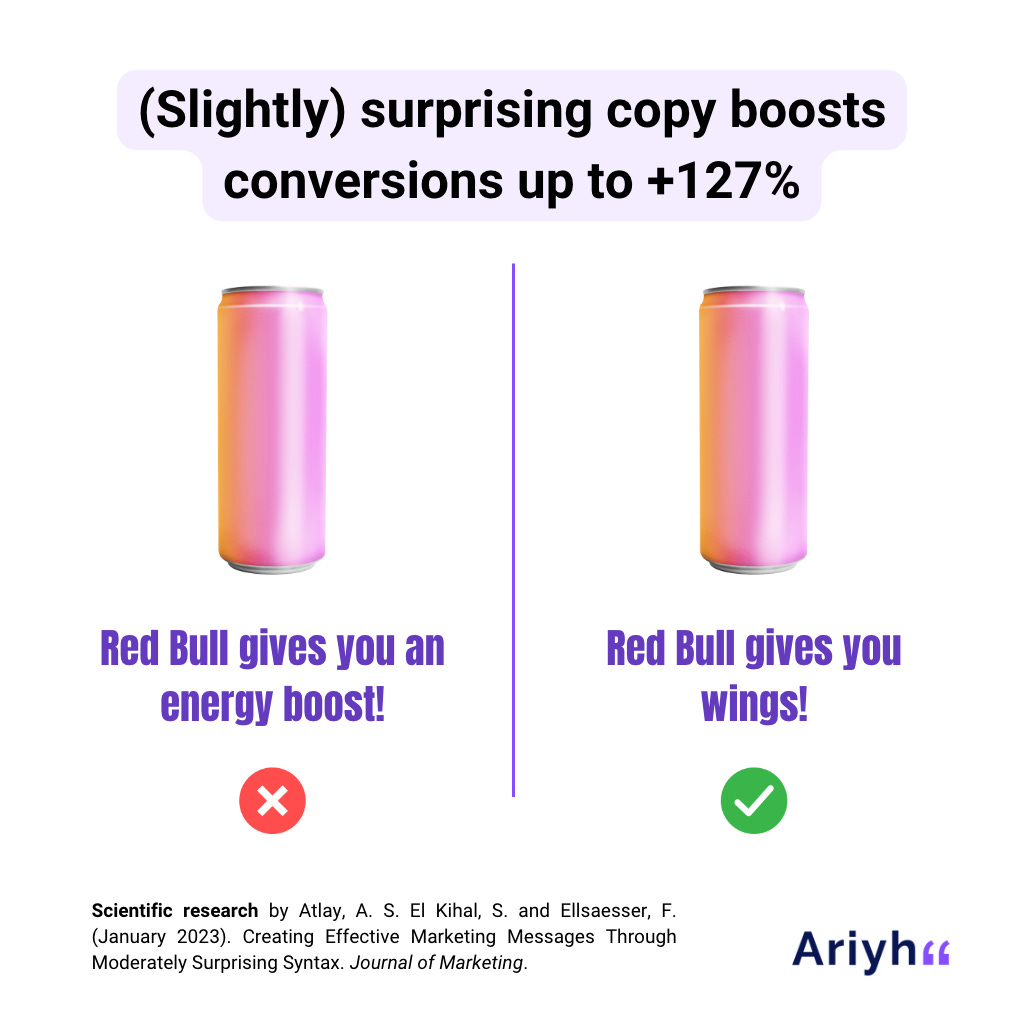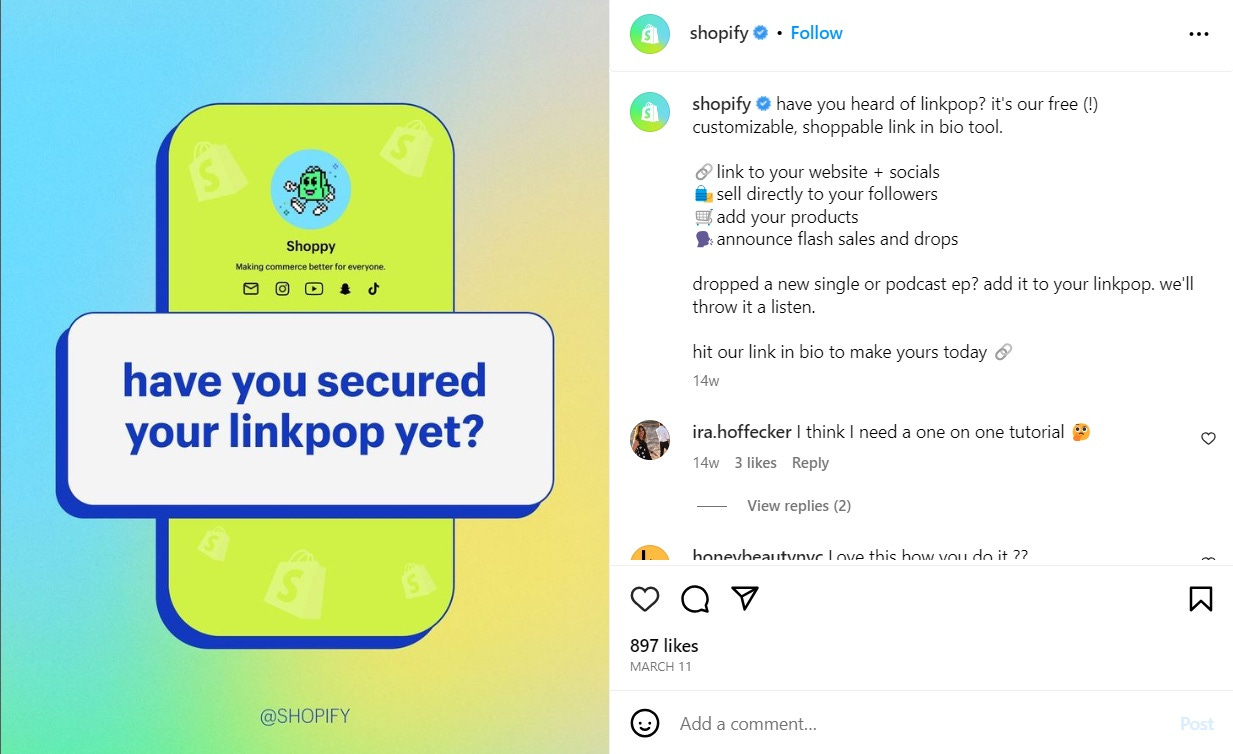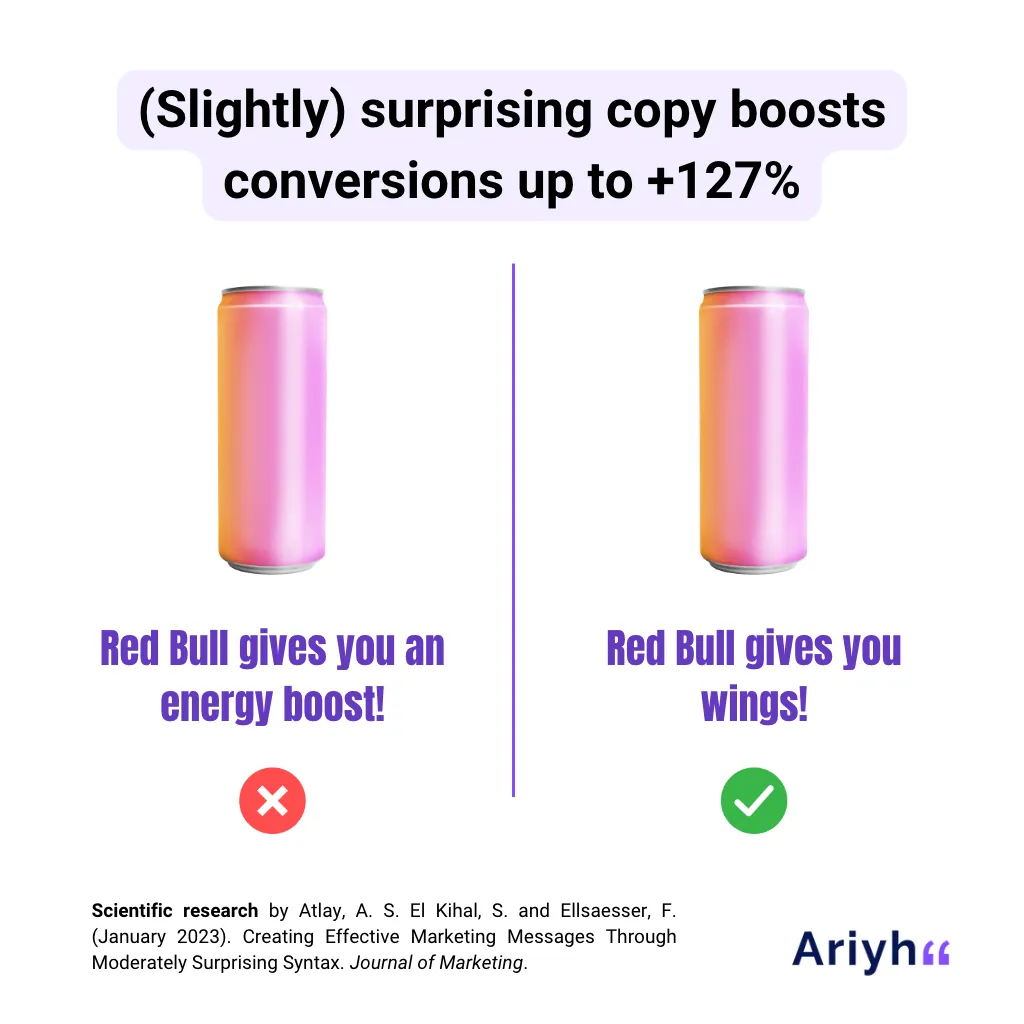by THOMAS MCKINLAY for Aryih
“Uber Eats delivers a delicious meal to your door”
vs
“A delicious meal at your door, by Uber Eats”
These sentences mean the same thing.
But the second one uses a less predictable order and combination of words. So people pay more attention to it.
Get the amount of surprise just right (just enough, but not too much), and you could get up to 127.5% higher click-through rates (CTRs).
If you’re a marketer or copywriter that likes to write fun and snarky copy, this is your dream come true.
Now you have scientific evidence that your copy works better than (most) bland ChatGPT-ish writing.
P.S.: Special shoutout to the researchers of this study.
Not only did they discover these very useful findings, but they went one step further and created a simple free tool that we can use to calculate how effective our copy will be.
Have fun with it – and crank up those conversions.
Previous insight: Headphones make you more persuasive (more insights here)
Use surprising words and sentence structure to make your messages more effective.
Channels: Messaging | Ads | Content | Copywriting |
For: B2C. Can be tested for B2B
Research date: January 2023
📈 Recommendation
Use sentence structures and words that are unexpected – but not so much that they become difficult to understand. Your copy will convert better, and people will be willing to pay more for your products.
For example:
- Instead of saying: “You don’t have to worry that your brow liner will wear off in a swimming pool, in a workout session, or anywhere else anymore!”
- Say: “Be it a gym or a pool – say goodbye to the days of worrying your eyebrows will come off!”
Your copy should have a surprise score of between 1.9 and 2.3 according to this Syntactic Surprise Calculator developed by the researchers.

🎓 Findings
- A sentence of the same meaning, but with moderately surprising syntax – how words in the sentence are structured – makes the message more effective. People were more likely to click on ads, find a review helpful, donate, or pay more for a product.
- The effect follows an inverted U-shape. It should be surprising, but not too surprising:
- Too low surprise copy is boring and predictable
- Too high surprise copy is hard to understand
- As part of 6 experiments and analyses of 15,000 Amazon reviews and experimental data, researchers found that:
- A Facebook ad for a fashion brand had a 74% higher CTR (1.6% vs 0.92%) when its ad copy used an unexpected passive voice tweak:
- Low surprise version (score 1.86): “…since we clean the seas and eliminate pollution to produce our fibers.”
- High surprise version (score 2.02): “…since the seas are cleaned and pollution is eliminated by [Brand]…”
- An Instagram ad for a beauty salon had an over 2x higher CTR (1.82% vs 0.80%) when the ad copy was tweaked to be more surprising:
- Low surprise version (score 1.62): “take a beauty break to get a Hydrafacial”
- High surprise version (score 2.11): “take a beauty break, get a Hydrafacial”
- A Facebook ad for a fashion brand had a 74% higher CTR (1.6% vs 0.92%) when its ad copy used an unexpected passive voice tweak:
🧠 Why it works
- We automatically analyze a sentence in parts, with expectations of how the rest of the sentence will flow.
- For example, past experience and our education lead us to expect that a verb (e.g. sell) will be followed by an object (e.g. books).
- If this expectation is broken, we’re surprised so we pay more attention to the sentence.
✋ Limitations
- The data focused on online content (e.g. Instagram, Facebook, product reviews) – it’s unclear whether this effect would hold offline, such as in print or billboards – but this is likely the case.
- The study did not explore audio messages. We don’t know whether this technique would have a positive effect in spoken sentences, or if it would backfire by causing confusion.
🏢 Companies using this
- Many brands try to be surprising. Some get it right, but many aren’t enough or go too far. For example:
- MasterClass gets an ideal score of 2.06 for their copy “Women’s history is happening now”.
- Old Spice is too predictable with a score of 1.53 for their ad copy, “Bald is a hairstyle too.”
- Halos is too surprising with a score of 2.69 for their ad copy, “Make lunch peel easy.”
Shopify gets a perfect surprise score of 2.03 for their Instagram post announcing their new linkpop feature.

⚡ Steps to implement
- Come up with multiple different variations of how you can say and structure the sentence of your message
- Test the different variations using the Syntactic Surprise Calculator developed by the researchers.
- Your sentence should have an ideal score of between 1.9 and 2.3
- Remember, you should be neither too predictable, nor too surprising and complex.
🔍 Study type
Field experiments (A/B tests of 4 Facebook ads and 2 Instagram ads, with over 350,000 impressions) and Market observation (analysis of over 15,000 product reviews on Amazon and of experimental data).
📖 Research
Creating Effective Marketing Messages Through Moderately Surprising Syntax. Journal of Marketing (January 2023).

🏫 Researchers
- A. Selin Atalay. Frankfurt School of Finance and Management.
- Siham El Kihal. Frankfurt School of Finance and Management.
- Florian Ellsaesser. Frankfurt School of Finance and Management.
Remember: This is a new scientific discovery. In the future it will probably be better understood and could even be proven wrong (that’s how science works). It may also not be generalizable to your situation. If it’s a risky change, always test it on a small scale before rolling it out widely.
